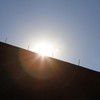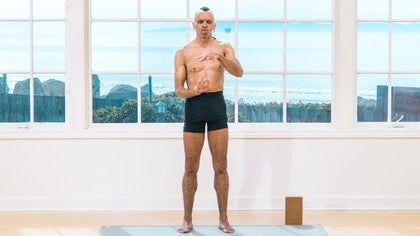Asana Studies: Active Tadasana
Chris Hoskins
Watch this Tutorial

Frederic M
Thanks Chris. Great and detailed explanations for a pose that seems so simple yet that can hold so much!
9 years ago
Hi Frederic, It is great that you are able to grasp the depth that is inherent in this simple pose. It is a wonderful pose in which to practice cultivating deep sense-feeling and enhanced presence; which is foundational for transposing that awareness to more complex and challenging poses.
9 years ago
This has breathed new life into my tadasana, really enjoying this series so far. One thing I'm struggling with - when I externally rotate the knees I feel like I'm undoing the action I did when I scuff the heels - it's hard to maintain those two actions simultaneously.
8 years ago
Hi Alice,
Thanks for doing your practice. It’s fantastic that this has breathed new life into your Tadasana! Active Tadasana practiced this way is quite a multi-dimensionally dynamic pose, but it is a bit tricky. The challenge you described of maintaining the opposing actions of the movement of the heels and knees is one of the trickiest parts of it.
Thanks for doing your practice. It’s fantastic that this has breathed new life into your Tadasana! Active Tadasana practiced this way is quite a multi-dimensionally dynamic pose, but it is a bit tricky. The challenge you described of maintaining the opposing actions of the movement of the heels and knees is one of the trickiest parts of it.
8 years ago
Alice (cont.) You seem to have a good understanding that it’s from scuffing the heels apart that you spin the knees out (externally rotate). Keep doing it that way. Make sure that you emphasize and give referential priority to the strong action of your heels, while keeping strong weight in them. In doing so you’ll probably spin the knees out much less in your intention to maintain both actions simultaneously, which is fine. In fact, just creating a clear neurological impetus – as opposed to a visually apparent movement – of spinning the knees out from the strong emphasis of scuffing the heels apart, is enough to send the lateral spiraling wave of external rotation from the feet up through the legs and thighs, into and through the pelvis, torso/spine and crown of the head.
8 years ago
Alice (cont.) An accessible context for playing with the relationship of these movements is sitting on a metal folding chair: Place your feet parallel with the outer edges of your heels slightly narrower than the width of your hips. Lean forward and put strong weight through your heels into the floor as you shape your feet. Then press the tips of your middle fingers firmly against outer edge of each heel, about an inch – or slightly more – forward from the back of the heels. Now strongly scuff your heels out to meet the pressure of your fingers, while using the fingers to block the outward movement of your heels’ scuffing action. Then from the pressure of your fingertips on your outer heels, spin the knees out without diminishing the strong quality of contact between your heels and fingertips, or allowing the heels to move toward each other. As you do this continue maintaining strong weight through your heels into the floor and enhancing the shaping of your feet.
8 years ago
Alice (cont.) You can do the above actions with your pelvis at the back, center or front edge of the chair and with your feet more forward or back; experiment with different positions to find which gives you the most access to the movements. You can also try it with your feet closer to each other, although it is generally easier to create the movement relationship actions with the feet wider (slightly narrower than the width of your hips) because the hips joints are more fluid than when the feet are closer to each other. Once you get the hang of it sitting on the chair, try doing it the same way in Utkatasana – also starting with the feet wide then gradually moving them closer to each other.
Perhaps if you play with the actions while sitting on a chair, and then crouched in Utkatasana, you will be able to transfer them to Tadasana. Keep in mind that the wave of inhalation is generally the breath support movement that is affined with spinning the knees out.
Perhaps if you play with the actions while sitting on a chair, and then crouched in Utkatasana, you will be able to transfer them to Tadasana. Keep in mind that the wave of inhalation is generally the breath support movement that is affined with spinning the knees out.
8 years ago
That's brilliant Chris, thank you so much for taking the time to give me such a detailed answer! I will read through this a few times and then work through as you suggest. Thanks again!
8 years ago
You need to be a subscriber to post a comment.
Please Log In or Create an Account to start your free trial.







